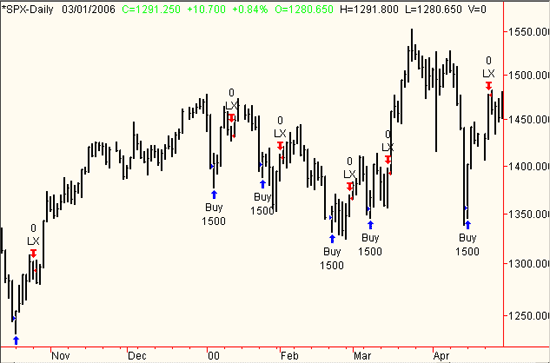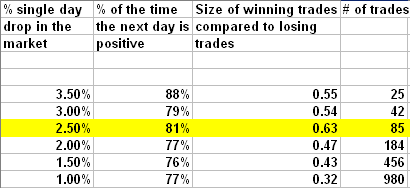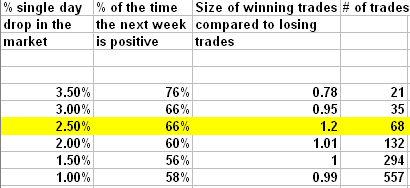Look at this chart of the SPX and these mechanically generated entries:

Now, this must be some sort of sophisticated system right? No. This system consists of buying the SPX at open the day after a market drop of 2.5% or greater and holding it until close five days later. Just take a good look at these entries. They were all profitable trades and good times to enter the market for a week.
The last few days have shown some significant market volatility. Of course, it's really nothing compared to what we saw from 1999 to 2002. But how should we really react to significant drops in the marketplace? Should we duck and run for cover? Specifically, what should we do the day after a large market drop? What about the week after? Today, we will look at some historical data and offer some answers and conclusions to these questions.
A Signicant Daily Drop and The Day After

This chart shows how frequently the market drops significantly in a single day and what has happened on the following days. This data comes from Tradestation and assumed that the day following the drop, you buy the SPX at open and sell at close the same day. The number of trades figure you see on the right, shows the numbers times the respective drops in the market occurred from 1970 to present. As you can see, it is highly probable that the day following a large drop in the market, the market will move higher. The sweet spot is 2.5%. The most profitable method since 1970 is to wait until the market drops 2.5% and then buy the market the next day.
But what if instead of holding the market for just one day after a big drop, you held on for a week?
Results After Holding the Market For A Week After a Significant Daily Drop

Holding on to the market for a week after a huge drop is even more profitable. Most of the time after a big daily drop, the market is up the following week. Not only that, the average winning trade size is about the same as the average losing trade. Therefore, this method is highly profitable and can be used a market timing tool. If you are looking to go long in a position, going in right after a big drop in the market would be an ideal time. Don't forget this the next time you are swing trading and the market plunges one day.
What about when the market surges? The data that we gather did not show that selling the market short after a surge would prove highly profitable. There is one exception though. That is when the market surges over 3.5%. That hasn't happened since March of 2003. In fact, it's only happened times since 1970 and the bulk of it happened from 1997-2002. When the market has surged over 3.5% it has proven to be highly profitable to buy a position at open the next day and hold it until close the following day. This trade is only profitable 47% of the time but when it is profitable, the winning trades are 2.5 times larger than the losing trades on average. In conclusion, the data does not suggest to go short when the market surges. It's not profitable in the long run with once exception- when the market surges over 3.5%. But this rarely happens.
The bottom line here is this: do not panic and turn into a bear when the market drops significantly in a single day. This is usually the precise time when you should get bullish and history has proven it. The key here though lies in causation. Is there real causation here, or is just a coincidence. Our contention is that this phenomenon clearly involves causation. When the market is jittery or there is a bad news story like the bombing last year in Great Britain, is the market really worth 2.5% less? Of course not. The market tends to overreact - particularly to negative news. This is based on fear-driven selling. If everyone is rushing to sell at the same time, the market will drop! It just drops more than it should and within the week, the smart money is making money from the fear. Are you part of the smart money, or the "other" money?
Be disciplined, and trade well!
Price Headley is the founder and chief analyst of BigTrends.com.